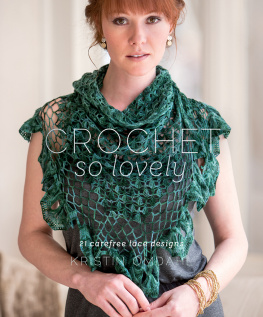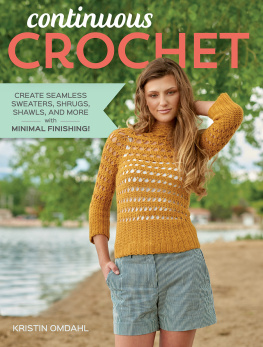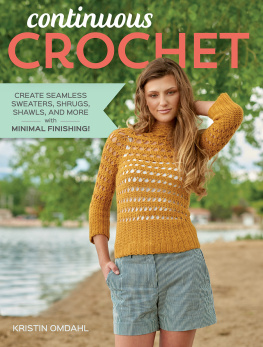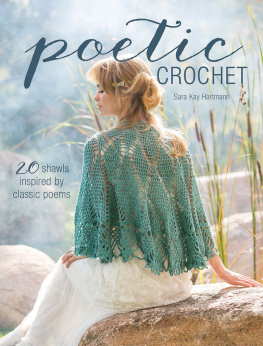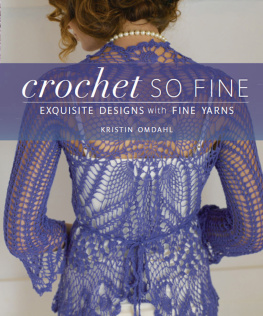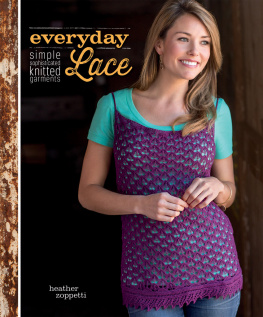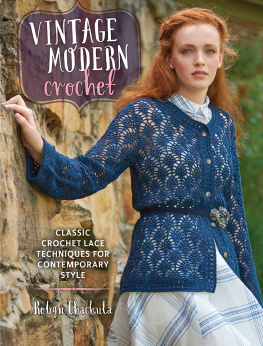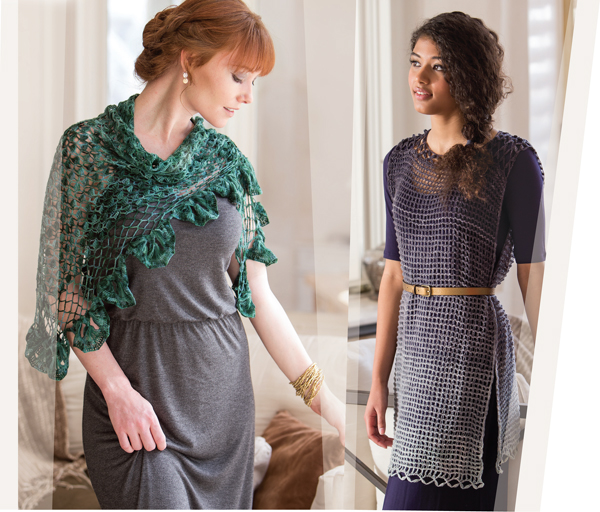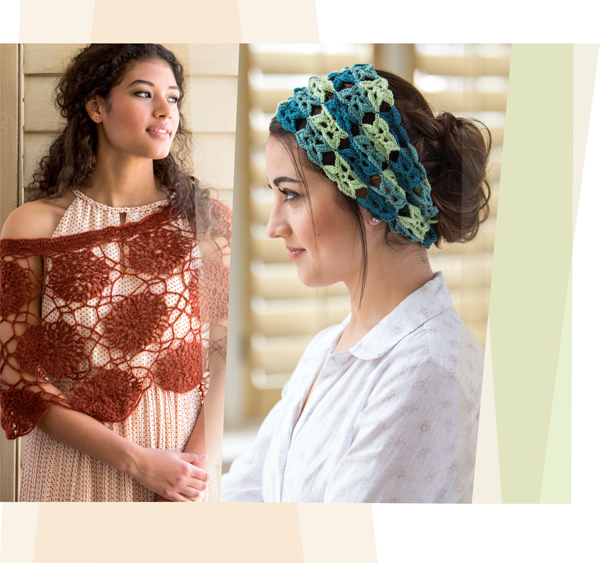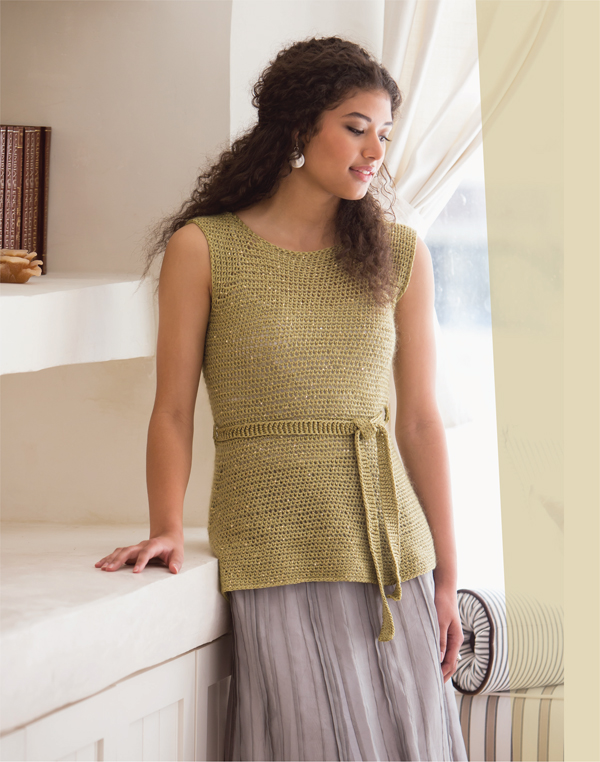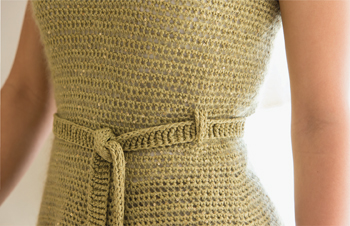Contents
Guide
21 Carefree Lace Designs
Kristin Omdahl

A special thank-you to my SharkHunter: my sweet, talented, and good-natured son. The seeds of my wonderful career began while you were still growing in my belly. Now, some twelve years later, I watch with ever-increasing pride as you blossom into the man you will become. You continue to inspire me beyond words; I feel truly blessed and love you so much.
CONTENTS
Introduction
This collection is truly dear to my heart. As a math fanatic who often gets really focused on the construction and technical aspect of design, but also loves fashion and dressing up, I thought Id challenge myself to design a collection of romantic, feminine, and girlie wearables after my own heart. Before I began this book, I promised myself I would ask this question for each piece: If money were no object and I was going on a very special date with Prince Charming, would I still wear this? If I couldnt say yes, it didnt make the cut. I thought of the kind of outings and the types of looks I would want to wear, and this book is the result of it.
These designs are wearable and versatile for all of your adventuresfrom sunset beach picnic, to afternoon art festival, to live and local acoustic concert, to weekend getaway, and beyond. I poured my heart into this collection and enjoyed the process very much. I have many favorites and couldnt possibly choose one. The felted bag makes me squeal with delight. The trapeze tank top looks good worn so many ways, the hairpin lace motifs (in two projects) are gorgeous and mesmerizing, and my love of floral inspiration is quite strong throughout the collection. And, the technical side of me was able to squeeze in a few crazy techniques (wouldnt you be disappointed if I didnt?).
Im so excited to share this book with you. I hope you enjoy making (and wearing) these pieces as much as I do!
CHAPTER ONE
Lace by Gauge
What is lace? To me, it is a pattern composed of the negative space and geometric structuring of a network of crossed paths of string. This can be accomplished in so many ways, from very simple to supercomplicated. This chapter is an exploration of the truly simple: playing with gauge.
Gauge is always critical when making lace. Blocking is mandatory; whether intentional or accidental, it will relax your gauge. Using oversized hooks for the weight of your yarn will accentuate the relaxing of your gauge in the blocking. Using simple stitches and oversized hooks gives you a remarkable lace structure after blocking, and often it makes it difficult to recognize otherwise common stitches!
Simply Sparkly Tunic
Alternating rows of proper gauge with very loose gauge in simple single crochet is an interesting way to create a lacy pattern and drape. You could achieve this by switching hook size with the same yarn, or as I did in this sweater, alternating weights of yarn with the same sized hook.
The thicker (ribbon) yarn uses the proper sized hook (H/8), and I used a laceweight mohair held together with a carryalong (thinner than laceweight) sequined yarn for the alternating row, but I continued with the same hook. The finished fabric, after blocking, has lots of negative space and really opens up the pattern. It looks like a stitch pattern rather than rows of easy-peasy single crochet. And the added sparkle of sequined yarn is just plain fun!
Yarn
Worsted weight (#4 Medium).
Shown here: Tahki Stacy Charles S. Collezione Stella (74% silk/26% lurex metallic; 76.5 yd [70 m]/0.88 oz [25 g]): #10 Northern Lights (A), 6 (7, 8, 10, 11) balls.
Tahki Stacy Charles S. Collezione Luna (71% super kid mohair/20% silk/9% Lurex; 232 yd [212.5 m]/0.88 oz [25 g]): #09 Northern Lights (B), 2 (3, 3, 4, 4) balls.
Tahki Stacy Charles S. Collezione Crystal (85% polyester/15% cotton; 144 yd [131 m]/0.88 oz [25 g]): #12 Northern Lights (C), 3 (4, 4, 5, 6) balls.
Hook
H/8 (5 mm) or size needed to obtain gauge.
Notions
Yarn needle; stitch markers.
Gauge
14 sts and 16 rows = 4" (10 cm) in sc in pattern, blocked.
Color Sequence
Pattern is worked in the following color sequence: *1 rnd A, 1 rnd B and C held together for one; rep from * throughout.
Stitch Guide
Foundation sc (Fsc): Start with a slipknot, ch 2, insert hook in 2nd ch from hook, draw up a lp, yo, draw through 1 lp, yo and draw through 2 lps1 sc with its own ch at bottom. Work next st under lps of that ch. *Insert hook under 2 lps at bottom of the previous st, draw up a lp, yo and draw through 1 lp, yo and draw through 2 lps, rep from * for length of foundation.
Front post double treble crochet (FPdtr): Yo (3 times), insert hook from front to back to front again around the post of next st, yo, draw yarn through st, [yo, draw yarn through 2 lps on hook] 4 times.
Notes
- This is a seamless, top-down construction pullover with cap sleeves and a longer, tunic length. Added stitches are worked into the lower body rounds for great hip ease. The belt loops are added as you go with long post stitches! This is a clever trick you can use on any belted sweater you make going forward.
- You could easily modify this sweater to add a collar, or longer sleeves, or even shorten the body. It has a streamline fit with minimal ease in the bust.
- You can easily alternate yarns every other rnd without cutting yarn at the end of every rnd. Just make sure to untwist every few rnds if they begin to twist up on themselves.
Yoke
With A, work 70 (78, 86, 94, 102) Fsc, without twisting foundation, join with sl st in first st to form a ring. Drop A to WS to be picked up later.

